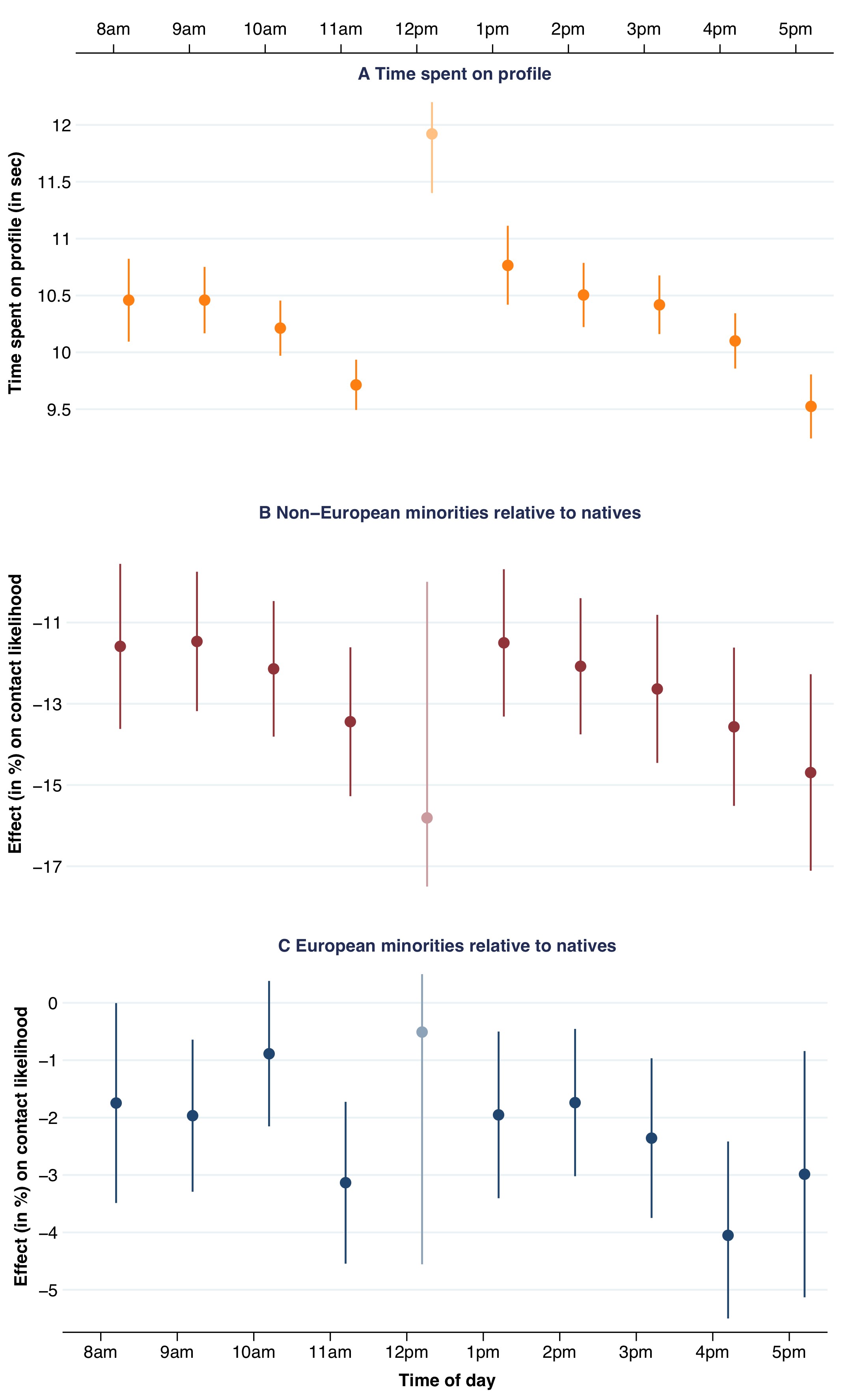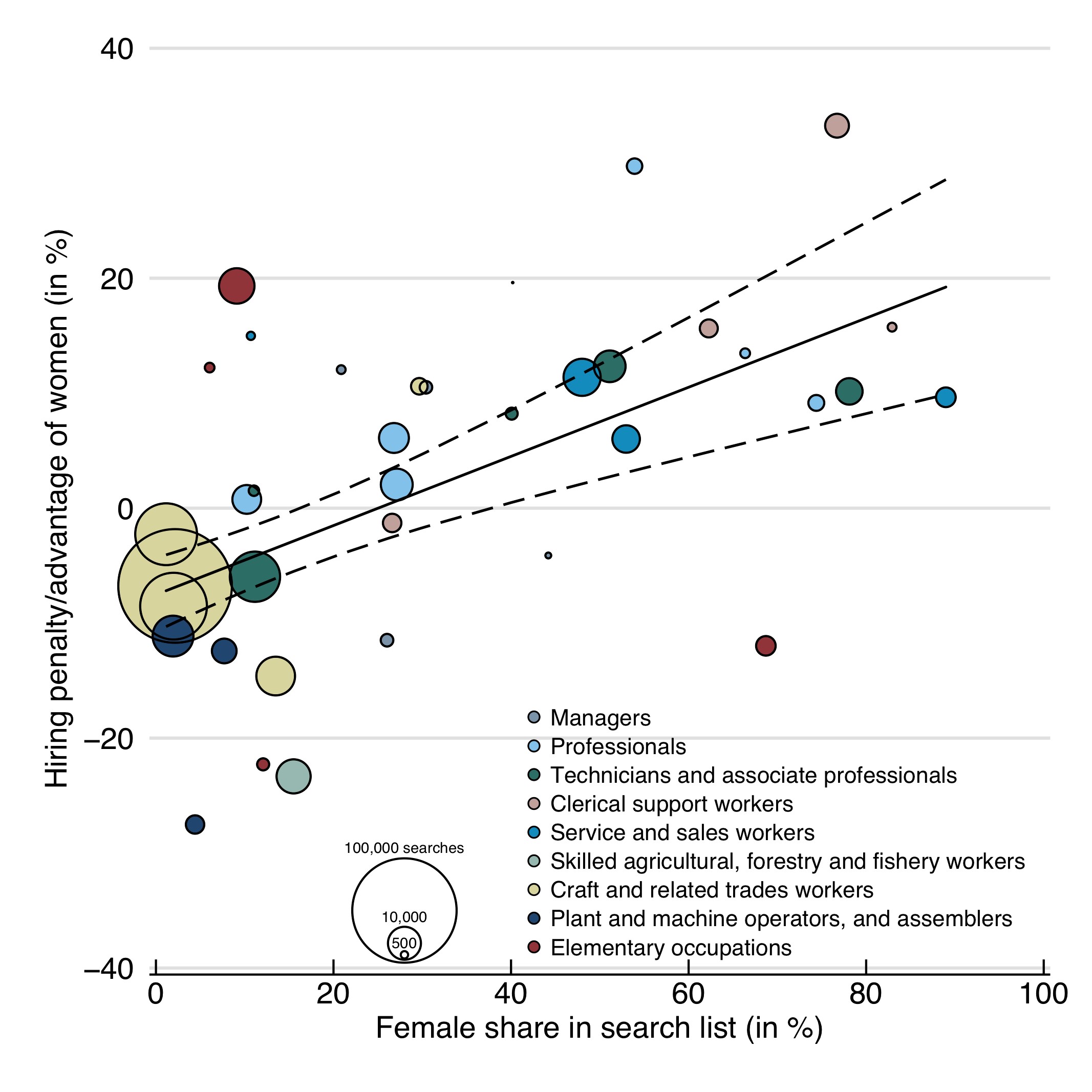Education and skills should be the key determinants of whether a candidate gets a job or not, but in reality, gender, origin or race/ethnicity end up influencing hiring decisions. By leveraging big data from recruitment platforms and machine learning to study hiring discrimination, Dominik Hangartner, Daniel Kopp, and Michael Siegenthaler show that discrimination against immigrants depends, among other things, on their origin and time of day; and that both men and women face discrimination.
Education, professional skills and experience are the essential criteria for filling a position – or at least that is the expectation. The reality often looks different, as numerous studies have shown. When deciding whether to hire a candidate or not, gender, origin or race/ethnicity sometimes also play an important role; factors that say little about a candidate’s suitability for a job. This type of discrimination violates the principle of equal opportunities. For those affected, this may have long-term disadvantages, such as longer unemployment or lower wages. And for society this leads, inter alia, to a waste of valuable human resources. This is why it is crucial to understand who is discriminated against, and why.
Previous research has mainly used correspondence studies to shed light on discrimination. In these studies, researchers send HR managers fictitious CVs that are identical except for the characteristic of interest, e.g., the applicant’s ethnicity. The researchers then record which applicants are invited to an interview. This is a costly and, because of its interference in actual hiring processes, not unproblematic procedure. Furthermore, correspondence studies are typically limited to few jobseeker characteristics and occupations.
Because of these limitations, we looked for another approach to study hiring discrimination. Our approach leverages the growing popularity of recruitment platforms and recent advances in supervised machine learning. To test our methodology, we collaborated with the State Secretariat for Economic Affairs (SECO) to gain access to anonymised data from Job-Room, one of the largest recruitment platforms in Switzerland. At any given point in time, Job-Room contains profiles of more than 150,000 job seekers. Recruiters hiring on Job-Room specify the criteria required for a particular job. They then receive a list of suitable candidates and can open their profiles. Among other things, the profiles contain information on expertise, gender, nationality and language skills of candidates. If recruiters are interested in particular candidates, they can contact them and invite them to a job interview.
Observing millions of decisions
This approach allows us to study discrimination across different professions and demographic groups with high resolution. Furthermore, we can analyse the entire search process on the platform: We know which candidates are displayed to recruiters, when and for how long they view a profile, and whether they click on the contact button. Over ten months, we observed millions of recruiter decisions for or against particular candidates. This large-scale and non-intrusive approach enabled us to determine how the ethnic origin or gender of a candidate influenced the likelihood of being contacted.
Discrimination is larger towards the end of the workday
Our results show that on average immigrant jobseekers were 6.5 per cent less likely to be contacted than Swiss jobseekers with otherwise identical characteristics. This discrimination was particularly pronounced for migrants from the Balkans, Africa, the Middle East and Asia, who are often faced with prejudices in everyday life.
Figure 1. The effects of jobseeker characteristics

Panel A shows the effects of jobseekers’ characteristics and associated cluster-robust 95% confidence intervals on the probability of being contacted (n=3,251,303 profile views). Panel B shows the effects of jobseeker characteristics and associated cluster-robust 95% confidence intervals on the log time that recruiters are looking at the profile (n=3,191,818 profile views). The hollow dots on the zero line denote the reference category for each jobseeker attribute. For the ethnicity indicators native Swiss citizens are the reference category.
We also find important variation across the recruiters’ workday. A jobseeker’s foreign origin has a stronger negative impact towards noon and in the evening – when recruiters review CVs faster. Hence, the same recruiter makes different decisions depending on the time of day. This result suggests that unconscious biases, such as stereotypes about minorities, also contribute to discrimination. These unconscious biases might play a larger role when we are tired or want to leave work.
Figure 2. Time recruiters spent at jobseeker profiles and the effect of ethnicity for non-EU immigrants

Panel A reports the average time that recruiters spend looking at jobseekers’ profiles during the workday (n=3,281,297 profile views). Panel B shows the effect of ethnicity for non-European immigrants compared to natives during the workday (n=3,341,209 profile views). Panel C shows the effect of ethnicity for European immigrants compared to native Swiss citizens (n=3,341,209 profile views). Dots with vertical lines indicate point estimates with cluster-robust 95% confidence intervals from ordinary least squares regressions.
We also find that both men and women face discrimination. Given equal qualifications, women are mainly discriminated against in typical male professions and men in typical female professions. In the five professions with the lowest proportion of women, women are 7 per cent less likely to be contacted than men. In the five occupations with the highest proportion of women, they are 13 per cent more likely to be contacted. This suggests that some recruiters still seem to believe that women are more suited to certain professions than men, and vice versa, thereby perpetuating occupational segregation across gender.
Figure 3. Occupation-specific gender penalties in hiring

Notes: Figure shows occupation-specific gender penalties in hiring (n = 17,369,372 profiles). The circles show the (dis)advantage that women face compared to men in a given occupation, plotted against the average share of female jobseekers in the same search in that occupation. The circumference of the circle is proportional to the number of searches in each occupation. The colour indicates the ISCO-1 level occupation classification. The solid black line shows the weighted least squares regression of the estimated, occupation-specific gender effect against the share of female workers in the searched occupation. The dashed black lines show 95% confidence intervals. Although the linear trend is estimated on the basis of all data, the figure does not show the 50% hiring penalty for women in the occupation ‘skilled forestry, fishery and hunting workers’.
Does digitisation lead to more discrimination?
Online platforms such as Job-Room are becoming an increasingly important tool for recruitment. Does that mean discrimination in hiring is growing? We do not expect this to be the case. There is little evidence that suggests that discrimination is more prevalent on online platforms than in traditional recruitment processes. Rather, discrimination is a structural and societal problem that is reflected across the entire labour market. But in the case of online portals, we can use the existing data to monitor hiring discrimination without interfering in the recruitment process. We hope that the findings from such monitoring will inform strategies to counter hiring discrimination and increase equal access to job opportunities.
♣♣♣
Notes:
- This blog post is based on Monitoring hiring discrimination through online recruitment platforms, Nature 2020.
- The post gives the views of its authors, not the position of LSE Business Review or the London School of Economics.
- Featured image © ETH Zurich, NOT under Creative Communs, All Rights Reserved
- When you leave a comment, you’re agreeing to our Comment Policy





